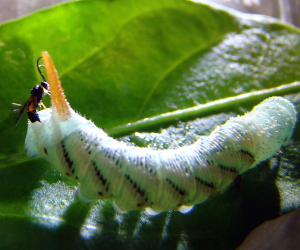Current Research
Site under construction!

Evolutionary ecology of Cotesia congregata
Parasitic wasps are among the most diverese terrestial animals, many of which display a remarkable degree of specialization on their hosts. They play important roles in natural ecosystems and in pest management for agriculture. What factors contribute to the extreme diversity of parasitic wasps? What are the steps in specialization and eventual speciation?
The parasitic wasp, Cotesia congregata (Braconidae), serves as an ideal model system for understanding the underlying mechanisms of parasitic wasp diversification. This species is reported to use around 15 species of sphingid larvae as hosts, most of which are plant family specialists. Recent genetic and behavioral research using wasps originating from Manduca sexta (tobacco hornworm) on solanaceous plants and Ceratomia catalpae (catalpa sphinx) indicate that C. congregata may consist of at least two reproductively isolated incipient species.
These two host-foodplant complex sources of C. congregata are genetically diverged based on COI gene sequences (2% difference) and microsatellite allele frequencies. When male wasps from the tobacco source are crossed with females from the catalpa source, the resulting female hybrids are sterile. Hybrid females from the reciprocal cross produce viable offspring. We are actively researching the genetic differences responsible for this post-zygotic barrier.
Chemical ecology of the catalpa system

Information coming soon!
Courtship songs in the genus Cotesia
All Cotesia have courtship displays that consist of wing fanning at different amplitudes which generates sounds. These amplitude modulated songs differ among Cotesia species that have been recorded. Courtship song characteristics can be used to distinguish even closely related species.
Past Research Projects

Information coming soon!